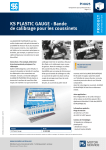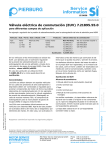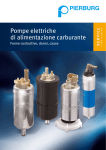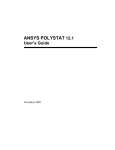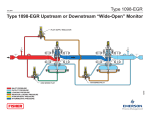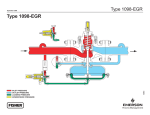Download Troubleshooting in exhaust gas recirculation system
Transcript
SI 0100
SERVICE
I N F O R M AT I O N
For technical personnel only!
Page 1/4
Troubleshooting in exhaust
gas recirculation system
on Otto and diesel engines
Vehicle
Products
all vehicles equipped with exhaust gas recirculation system
Pos. 2, 3, 5, 6, 7 (see figure)
Exhaust gas recirculation (EGR) is a reliable
and practice-proven method of emission
control:
As a result of exhaust gas, the oxygen content
in the air-fuel mixture is reduced, and consequently the combustion temperature in the
cylinders lowered.
Since harmful nitrogen oxides (NOx) are mainly
produced at high temperatures and pressures,
it is possible to reduce the NOx concentrates
emitted to the environment by up to 50%.
On diesel engines, the formation of soot
particulates is lowered by approx. 10%.
Exhaust gas recirculation is only activated
at defined operating points.
On petrol engines this is normally the case
above idling and up to upper part load, on
diesel engines up to approx. 3000 rpm and
medium load.
1
2
5
3
6
7
Principle of exhaust gas
recirculation (pneumatic)
8
4
1 Air filter
2 Air mass sensor
3 Throttle valve/control flap
4 Cylinder
5 EGR valve (in this case:pneumatic)
© MS Motor Service International GmbH – 0509 EN
!
6 Electropneumatic pressure transducer
Tips for troubleshooting
see page 3 and 4
7 Lambda probe (Otto)
8 Catalytic converter
EGR at a glance
Diesel engine
(all injection types)
Petrol engine
(manifold injection)
Petrol engine
(direct injection)
Effects
Nitrogen oxides -50%
Particulates -10%
Less hydrocarbons emitted
Less noise emitted
Nitrogen oxides -40%
Fuel consumption -3%
Less CO2
Nitrogen oxides -50…60%
Fuel consumption -2%
Less CO2
Return rates
Max. 65%
Max. 25%
Max. 50% (with stratified charge)
Max. 30% (with homogenous operation)
Others
EGR cooling is required for vehicles
with higher weight class
EGR cooling under discussion
High EGR rates at high load
Text and illustrations subject to change.
www.ms-motor-service.com
MS Motor Service International GmbH · 41540 Dormagen · Germany
KOLBENSCHMIDT PIERBURG GROUP
Replacement for SI 0038, SI 0039
SI 0100
For technical personnel only!
Page 2/4
Components of exhaust gas recirculation system (EGR)
The EGR valve meters the amount of recirculated exhaust gas.
It is added either at the exhaust manifold or at
the intake air system, or it is located in a heatresistant exhaust-gas pipe which connects the
exhaust manifold to the intake air system.
Pneumatic EGR valves are actuated by way of
vacuum via electromagnetic valves:
On basic systems with an electric switchover
valve, the EGR valve only has an open-close
function.
On systems provided with an electro-pneumatic
pressure transducer (EPW), the EGR valve is
infinitely adjustable.
The vacuum is taken from the intake manifold
or generated by a vacuum pump.
EGR valves on diesel vehicles have large opening cross-sections
because of their high return rates.
Left:
Pneumatic EGR valve
Centre: Pneumatic EGR valve with position detection
Right:
Electric EGR double-seat valve
Electric or electromotive EGR valves are actuated direct by the control unit and no longer
need any vacuum or solenoid valve.
On EGR valves in petrol engines, the cross-sections are considerably smaller.
Left:
Electric EGR valve with connection to the coolant circuit
Centre: Pneumatic EGR valve
© MS Motor Service International GmbH – 0509 EN
Right:
Electric EGR valve
Pneumatic EGR valves are actuated with the aid of
The air mass sensor is required on diesel engines,
Since the pressure difference between exhaust and
electro-pneumatic valves.
among other things for controlling the exhaust gas
intake side is inadequate for the high exhaust gas
recirculation.
recirculation rates on diesel vehicles, "regulating
throttles" are fitted into the intake manifold to
generate the required vacuum.
www.ms-motor-service.com
MS Motor Service International GmbH · 41540 Dormagen · Germany
KOLBENSCHMIDT PIERBURG GROUP
SI 0100
For technical personnel only!
Page 3/4
Tips for troubleshooting
The most common cause for malfunctions in the
EGR system are stuck or carbonised EGR valves.
Besides gaseous pollutants, recirculated
exhaust gas also contains soot particulates, in
particular in the case of diesel vehicles.
Due to oil in the intake air, carbon deposits or
carbon fouling are caused which eventually
the force of the valve can no longer cope with
ñ the EGR valve can then no longer open, or it
remains in its open position.
This results in jerking, irregular idling or insufficient engine power.
The causes of a high portion of oil in the intake
or charge air may be malfunctions in the
crankcase ventilation, worn bearings, a clogged
oil return line on the turbocharger, worn valve
stem seals or guides, the use of unsuitable
engine oil qualities or an excessive engine oil
level.
Though EGR valves are designed for the high
temperatures in the exhaust branch system,
heat damage to the valve may occasionally
occur.
Such damage can be caused by incorrect actuation, excessively high exhaust gas back pressure or a blow-off valve ("waste-gate valve") of
the turbocharger which does not open. There
may even be some manipulation ("tuning") to
increase the boost pressure.
On pneumatic EGR valves, one potential cause
of malfunctions can be found in the entire section of vacuum control (vacuum pump, vacuum
lines, solenoid valves).
Electric EGR valves and solenoid valves can
mostly be actuated by way of an actuator diagnosis by the engine tester.
Whenever a new EGR valve is installed after
a defect, and the vehicle behaves as if the
valve had not have been replaced at all, the
map data required for operation must first be
"re-learnt".
This is achieved either in the course of a longer
test drive or by using a specific program option
in the engine tester, e.g. "Basic settings".
We strongly advise against cleaning the EGR
components!
If a component really is already defective, no
improvement will be achieved by cleaning it.
And if functioning components are treated in
this way, they may be damaged as a result of
cleaning.
A defective component should always be replaced by a new one.
The switching of a functioning valve can easily
be heard when the engine is at a standstill.
© MS Motor Service International GmbH – 0509 EN
Exceptionnally intense deposits may also be
caused by faults in the injection system.
Since EGR valves do not soot themselves,
Salt and dirt may damage the sensor of an air mass
Whether dealing with pneumatic EGR valves or
it is essential to search for the causes of soot
sensor – they will at least falsify the measure-
an electro-pneumatic pressure transducer, as in
formation.
ments, which in turn could affect exhaust gas
this case: The function can easily be tested using
recirculation.
a vacuum hand pump.
www.ms-motor-service.com
MS Motor Service International GmbH · 41540 Dormagen · Germany
KOLBENSCHMIDT PIERBURG GROUP
SI 0100
For technical personnel only!
Page 4/4
Troubleshooting in exhaust gas recirculation system
Complaint
Potential causes
Remedies
• General: Coked/stuck EGR valve
- Poor, inadequate combustion
- Engine management fault
- Frequent short-distance drives
- Leaks in vacuum system
•
•
•
•
• Defective solenoid valves
• Malfunctions in vacuum system
• Check function, electrical actuation and
tightness of vacuum system
See below: "Vacuum system"
• High oil content in intake or charge air:
- Malfunctions in crankcase ventilation
- Engine oil level too high
- Low-quality engine oil
- Worn valve stem seal or guides
• Check oil separator, engine exhaust valve
• Check pistons, piston rings, cylinders, valve
stem seals and/or guides for wear
• Check turbochargers for clogged oil return line
• Change of oil and oil filter replacement
(by professional)
• Air mass sensor signal/other sensor signal
defective
• Check sensors for set-point values,
replace if necessary
• P0401 "Flow rate too low"
• P0103 "Air mass too high"
• EGR valve does not open or is not actuated
• EGR system has been shut down (the vehicle no
longer complies with the ABE!)
• Check connectors and actuation
• P0402 "Flow rate too high"
• P0102 "Air mass too low"
• EGR valve does not close/remains permanently open
• Uncontrolled, permanent exhaust gas recirculation
• Replace EGR valve
• Check connectors and actuation
• EGR valve has temperature
damage, visible discolouration,
initial fusing (Otto)
• Incorrect actuation
• Exhaust gas back pressure too high
• Blow-off valve of turbocharger does not open
• Replace EGR valve
• Check actuator of EGR valve
• Check exhaust gas back pressure
• Check blow-off valve of turbocharger
("waste-gate") and its actuation
• New EGR valve, inoperative
• High idling after installation
• New EGR valve has not been adapted
• Conduct a basic setting of EGR valve
using the engine tester
Caused by EGR valve
• Irregular idling
• Jerking
• Insufficient engine power
• Limp-home operation
• MIL lights up/error code set
• Insufficient engine power in
lower rpm range or in cold
run (Otto)
• Insufficient engine power in
upper rpm range (diesel)
Check engine controls
Check software update of engine control unit
Avoid frequent short-distance drives
Replace valve
Caused by vacuum system/solenoid valves
© MS Motor Service International GmbH – 0509 EN
•
•
•
•
Engine "chattering"
Engine misfires
Limp-home operation
Decreasing braking
performance
•
•
•
•
Defective hoses (porous, damaged by marten bites)
Leaking connectors on pneumatic valves
Leaking non-return valves/vacuum reservoir
Defective/porous diaphragms or seals on
pneumatic actuators
• Leaks in intake manifold
• In the event of damage, check the tightness
of all components in the vacuum system and
replace defective part
• Air mass sensor damaged/dirty due to
- Dirt particles in intake air
- Leaks in intake air system, splash water
- Contamination during air filter replacement
- Clogged air filters
- Oil-moistened sports air filters
• Avoid any intake of water and particles
into intake air system
• Damage to turbocharger
• Check turbocharger
Caused by air mass sensor
• P0401 "Flow rate too low"
• Black smoke
• Inadequate engine
performance
• Limp-home operation
EGR = Exhaust gas recirculation; MIL = Malfunction Indicator Lamp
www.ms-motor-service.com
MS Motor Service International GmbH · 41540 Dormagen · Germany
KOLBENSCHMIDT PIERBURG GROUP






